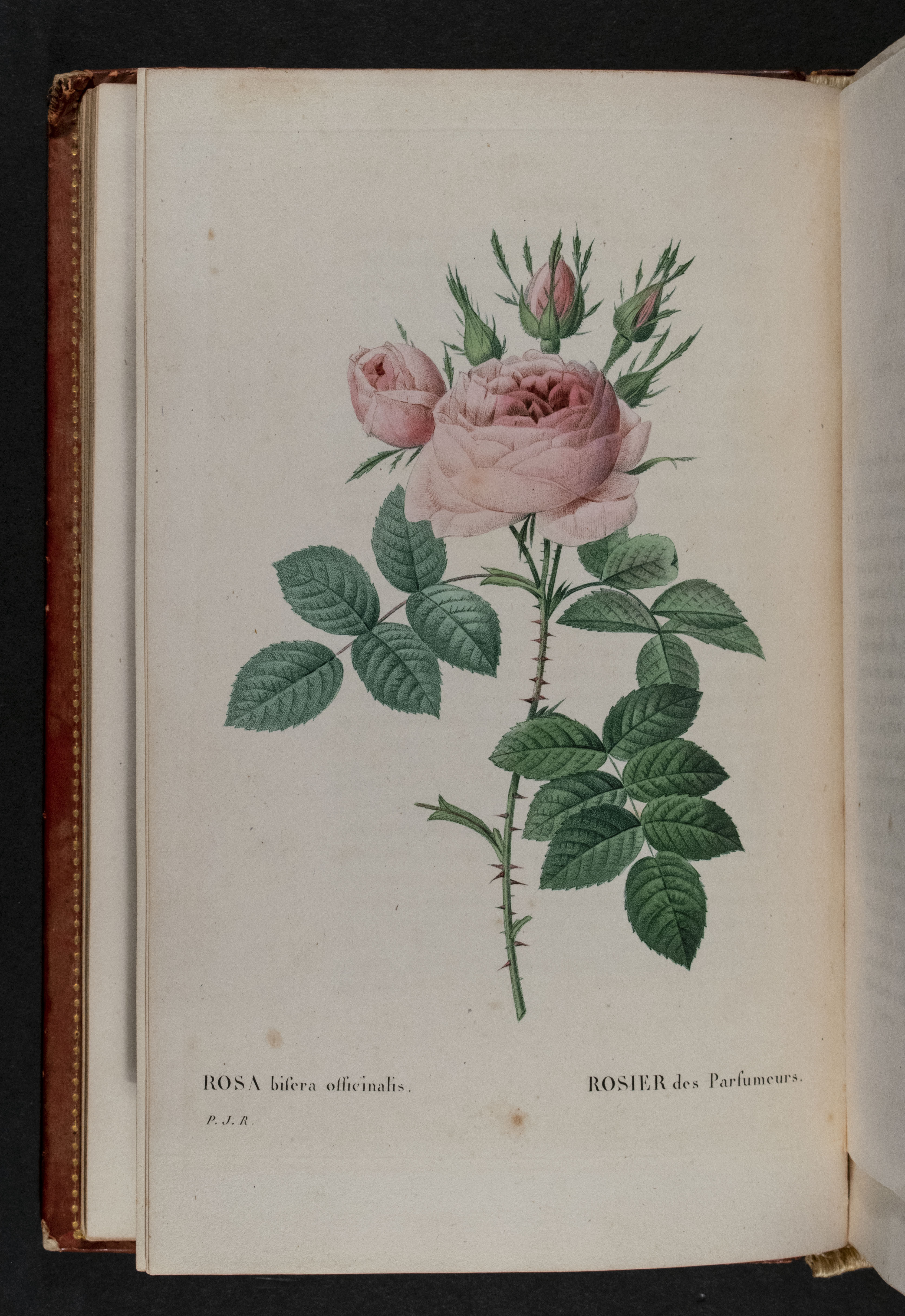During the Renaissance, the printed book perpetuated awareness of ancient scientific knowledge. The works of authorities such as Dioscorides and Theophrastus appeared in print during the first half of the sixteenth century. These books, known as herbals, described plants and instructed readers on how to use them for the treatment of illnesses. The first printed herbals did not have illustrations. Soon, woodcuts and later, engravings, lithography and other methods allowed for increasingly detailed images. As knowledge increased in various scientific domains, illustration techniques were used to render the information visible. This was particularly important with regard to direct observation of the natural world, of great significance in both science and art. Like scientists, illustrators and artists consciously invoke earlier traditions in the production of new works.
In many books in this area a blend of aesthetic and scientific interest is evident. Some illustrators use elegant compositions, appealing colors, and a sense of narrative to enrich scientific texts. More recent and contemporary creators at once reference old traditions of scientific representation and book format, while disrupting or deconstructing these traditions for experimental, artistic, and poetic purposes.
Author: Pedanius Dioscorides (Greek, ca. 40 A.D.-ca. 90 A.D.)
Illustrator: anonymous
Krauterbuch. Gedruckt zu Frankfurt am Mayn: Durch Erasinum Kempffern, Verlegung Conrad Corthoys, 1614.
Special Collections
woodcuts with hand coloring
This volume is a German translation of the ancient, authoritative encyclopedia De Materia Medica. The fact that Dioscorides was being translated early in the seventeenth century attests to his longstanding influence. Note the vividness of the colors used for the hand-painted woodcuts, and the Gothic or “black letter” type, which continued to be used in Germany even as fonts based on ancient Roman lettering became common elsewhere in Europe.
Author and Illustrator: anonymous
The grete herball whiche gyueth parfyt knowlege and vnderstandyng of all maner of herbes... Southwarke: Peter Treveris, 1529.
Special Collections
woodcuts on paper
This is the second edition of the first illustrated herbal in English. Herbals combined descriptions of plants with information on their usefulness in treating ailments. In this particular example, woodcuts represent both plants and activities such as planting and harvesting. For the most part, this work is a translation of a French herbal Le Grant Herbier, first printed in 1486, and its woodcuts were copied from Dutch editions of the French text. The images are uncolored, a common practice during this period. Any coloring would have to be applied by hand.
Author: Robert Hooke (British, 1635 – 1703)
Illustrator: anonymous
Micrographia Restaurata, or, The Copper-plates of Dr. Hooke’s wonderful discoveries by the microscope...
London: Printed for and sold by J. Bowles, 1745.
Special Collections
Author: Robert Hooke (British, 1635 – 1703)
Illustrator: anonymous
Plate XXI. The Face and Eyes of a Drone Fly
engraving on paper
The microscope was first invented in the later part of the sixteenth century. Scientist Robert Hooke made improvements to the device, and also produced the first book to display images of objects as seen through its lens. These engraved illustrations are based on Hooke’s drawings. During a period before the advent of photography, the book presented the microscopic and insect worlds to the public for the first time. This revised version reuses most of the plates from Hooke’s earlier text, Micrographia, published in 1665.
Author: Robert John Thornton (British, 1768 – 1837)
Illustrators: Joseph Constantine Stadler (German, 1780 – 1812);
Peter Charles Henderson (British, 1791 – 1829)
The Temple of Flora, or, Garden of the Botanist, Poet, Painter, and Philosopher. London: Dr. Thornton, 1812.
Special Collections
Author: Robert John Thornton (British, 1768 – 1837)
Illustrators: Joseph Constantine Stadler (German, 1780 – 1812);
Peter Charles Henderson (British, 1791 – 1829)
The Winged Passion Flower
engraving on paper
The Temple of Flora was originally published in 1799 as part of Robert John Thornton’s A New Description of the Sexual System of Carolus von Linnaeus. Thornton intended the book as a monument to the work of the Swedish botanist, well known for both his system of naming and for his writings on sexual reproduction in plants. In preparing the illustrations for his own book, Thornton employed painters and engravers to produce glorious floral images against beautiful backdrops. No expense was spared, as the goal was to assert Britain’s importance in the rapidly expanding domain of botanical knowledge. While ostensibly scientific in inspiration, The Temple of Flora is suffused with a Romantic world view, as seen in both the stylized images and the many poems that fill the pages. The cost of this ambitious endeavor ruined Thornton financially. Nonetheless, The Temple of Flora is considered one of the finest works of botanical illustration ever produced.
Author and Illustrator: Jim Dine (American, b. 1935)
Editors: Glenn Todd and Nancy Dine.
The Temple of Flora: Twenty-eight Drypoint Engravings. San Francisco: Arion Press, 1984.
Special Collections
Author and Illustrator: Jim Dine (American, b. 1935)
Editors: Glenn Todd and Nancy Dine.
Passion Flower, plate XXII
engraving on paper
In 1984 well known artist and printmaker Jim Dine produced a book inspired by John Robert Thornton’s Temple of Flora from 1812 (on view nearby). Dine used color prints from the older book as models for his own illustrations. Each of the artist’s engravings is paired with a poem by a well-known twentieth-century poet. These include Hilda Doolittle, Ezra Pound, e e cummings, Sylvia Plath, William Carlos Williams and others. The book also invokes the tradition of botanical writing by providing a page-long description of each type of flower featured. The botanical notes were compiled by Glenn Todd, a co- editor of the volume.
Author and Illustrator: Jim Dine (American, b. 1935)
Editors: Glenn Todd and Nancy Dine.
The Temple of Flora: Twenty-eight Drypoint Engravings [box lid]. San Francisco: Arion Press, 1984.
Special Collections
Author and Illustrator: Jim Dine (American, b. 1935)
Editors: Glenn Todd and Nancy Dine.
Details from Nancy’s Garden
bonded bronze sculpture
John James Audubon (born Jean Rabin, American, b. San Domingue- now Haiti, 1785-1851)
Printer/publisher: J.T. Bowen (American, c. 1801 - c. 1856)
Sciurus Carolinensis GMELIN/ Carolina Grey Squirrel/ Natural size/ Male & Female, 1843
From: The Viviparous Quadrupeds of North America
hand-colored lithograph on paper
Museums Collections
Following the enormous success of The Birds of America (1827 - 1838), naturalist John James Audubon embarked on his next major project in the 1840s – in this case documenting mammals of North America. He made 150 drawings with the help of his son John Woodhouse Audubon at this large scale, approximately 22 x 28 inches. They were hand printed and hand colored with the help of publisher J.T. Bowen in Philadelphia. As with many of Audubon’s studies after nature, he draws the viewer in by creating a sense of narrative action between the two animals and imbuing them with a sense of character. The beautiful draftsmanship, artistry, and this sense of activity blurs the lines between science and artistic license.
John James Audubon (born Jean Rabin, American, b. San Domingue- now Haiti, 1785-1851)
Printer/publisher: J.T. Bowen (American, c. 1801 - c. 1856)
HYSTRIX DORSATA, LINN/Canada Porcupine/ 4/5 natural size, 1844
From The Viviparous Quadrupeds of North America
hand-colored lithograph on paper
Museums Collections
Edward Lear (British, 1812 -1888), illustrator
Charles Joseph Hullmandel, (British, 1789 - 1850), printer
Phalacrocorax Punctatus, c. 1840
from Birds of Australia
hand-colored or stencil colored lithograph
Museums Collections, Gift of Mrs. John Sloan
This delicately rendered, hand-colored or stencil-colored lithograph was made by a particularly multifaceted cultural figure from the nineteenth century. Edward Lear may be best remembered today for his poetry, and particularly his nonsense poems, but he was also a skilled and successful watercolorist. Animals were among his favorite subjects in several different contexts.
This type of bird is more commonly known as a spotted shag or pārekareka. It is a species of cormorant from New Zealand. This image was published in John Gould’s Birds of Australia, a project issued in seven volumes from 1840 to 1848 with a later edition issued in 1868. According to the description in Gould’s volume accompanying Lear’s image, this specimen was collected by “Capt. G.R. Lambert, R.N., of H.M.S. Alligaotr, who procured it in New Zealand, where it is said to be abundant, particularly in Queen Charlotte’s Sound”.
John Gould (British, 1804 -1881) and Henry Constantine Richter (British, 1821-1902), illustrators
Charles Joseph Hullmandel, (British, 1789 – 1850), printer
Circus Jardinii: Gould, [Jardine’s Harrier], c. 1840
from Birds of Australia
hand-colored lithograph on paper
Museums Collections, Gift of Mrs. John Sloan
Author: Claude-Antoine Thory (French, 1759 - 1827)
Illustrator: Pierre-Joseph Redouté (French, 1759 - 1840)
Les Roses. Paris: C.L.F. Panckoucke, 1824.
Special Collections, Gift of Richard S. Hutton
Author: Claude-Antoine Thory (French, 1759 - 1827)
Illustrator: Pierre-Joseph Redouté (French, 1759 - 1840)
ROSA bifera officinalis/ ROSIER des Parfumeurs
stipple engraving on paper
This lush compendium of roses includes descriptions by botanist and rose-enthusiast Claude-Antoine Thory. Each entry is preceded by a detailed image by Pierre-Joseph Redouté, one of the greatest botanical illustrators. This page showing the rose of perfumers visually describes flowers in different stages of bloom, two buds, leaves, and the thorny stem.
Produced for Napoleon Bonaparte’s first wife the Empress Josephine, Les Roses includes many of the roses from Malmaison, Josephine’s residence outside Paris. Redouté made the plates with stipple engraving, in which images are conveyed through engraved dots rather than lines. The technique allowed Redouté to achieve a subtlety of color and shading almost equal to those in his original paintings. He claimed to have invented the process of using stipple engraving to print multiple colors on a single plate in 1796 - a claim that was upheld in the French courts. It earned him a medal from King Louis XVIII.
Author (page shown): Celia Gilbert (American, b 1932)
Illustrator: Enid Mark (American, 1932 - 2008)
Ars Botanica.
Wallingford, Pennsylvania: The Elm Press, 2004.
Copy 3 of 40
Special Collections
Author (page shown): Celia Gilbert (American, b 1932)
Illustrator: Enid Mark (American, 1932 - 2008)
[Peony]
duotone lithograph and lithograph on paper
This volume of poems by fourteen female poets explores the boundaries and connectedness between science and art. It asks the viewer to contemplate the role of illustration in scientific books and the desire of artists to create aesthetic responses to the formats of scientific volumes. The pages shown display Enid Mark’s visual response to Celia Gilbert’s poem, “About the Peony, Festiva Maxima”.
According to the colophon –
“This compilation of poems and images is inspired by the long tradition of herbariums and botanical books, especially those published in Europe from the 17th Century onward. In this edition the scientific description of flora featured in earlier volumes is replaced by poetry in which plants serve as the central image or metaphor. The poems, with one exception, were written specifically for Ars Botanica; the images were created in response to them.”
Each illustration involves two technical processes. Facing the text, there is a large photo-based duotone lithograph of the plant and a second lithograph made from a drawing of the plant and printed on a transparent sheet bound between the photographic lithograph and the poem.
John James Audubon (born Jean Rabin, American, b. San Domingue- now Haiti, 1785-1851)
Author: John Bachman (American, 1790 - 1874)
Illustrator (of this plate): John Woodhouse Audubon (American, 1812 - 1862)
Lithographer (of this plate): William E. Hitchcock (American, c. 1822 - c. 1880)
The Quadrupeds of North America, Volume III. New York: V.G. Audubon, 1854.
Special Collections
John James Audubon (born Jean Rabin, American, b. San Domingue- now Haiti, 1785-1851)
Author: John Bachman (American, 1790 - 1874)
Illustrator (of this plate): John Woodhouse Audubon (American, 1812 - 1862)
Lithographer (of this plate): William E. Hitchcock (American, c. 1822 - c. 1880)
Large-Tailed Skunk
color lithograph on paper
This multi-volume set of books presents studies of quadruped mammals of North America by John James Audubon and his son John Woodhouse Audubon. The set was published a few years following John James' death in 1851. Artistic choices - elegant compositions, bright colors, and a sense of personality for the animals - contributed to the popularity of this scientific work. Each animal is described in great depth combining scientific notations with other types of narrative text. Some animals are recorded with individualized details. For instance, we learn that this large-tailed male skunk was killed on January 28, 1846. The entry also moves away from purely scientific language by including lively excerpts from John Woodhouse's journal detailing his adventures in the animal's typical environment of Texas and New Mexico. Here, lithographer William E. Hitchcock translated John Woodhouse's drawing into a colored lithograph for the illustration, which was printed by J.T. Bowen of Philadelphia.
Printer: Ann E. Kalmbach (American, b. 1950).
Bookbinder: Tatana Kellner (American, born Czechoslovakia, b. 1950)
Pistol/ Pistil: Botanical Ballistics. Rosendale, New York: Women’s Studio Workshop, 1997.
Special Collections
Stamen / Pistil / Petal / Sepal: Parts of a Flower
Silkscreen and collage on paper
This artistic response to the idea of a botanical book occurs largely through word play, rhyming, and visual punning. The double-page selection provides an example of the theme suggested by the book’s title, Pistol/ Pistil equating botanical language with the language of guns. The Women’s Studio Workshop description explains that the book “examines the use of ordinary words in both botanical and military context. These definitions are juxtaposed with stories and statistics relating to farming and violence.”
Without following a conventional narrative, the silkscreened pages address gun violence, environmental destruction, agriculture, war, and oppression. Each page involves graphic design, often with text integrated into or overlaid on the imagery. Through collage and even the inclusion of real plant parts, the artists draw physical connections between topics that on the surface may seem disparate. Tatana Kellner constructed the binding out of wood, leather straps, and bullet casings.



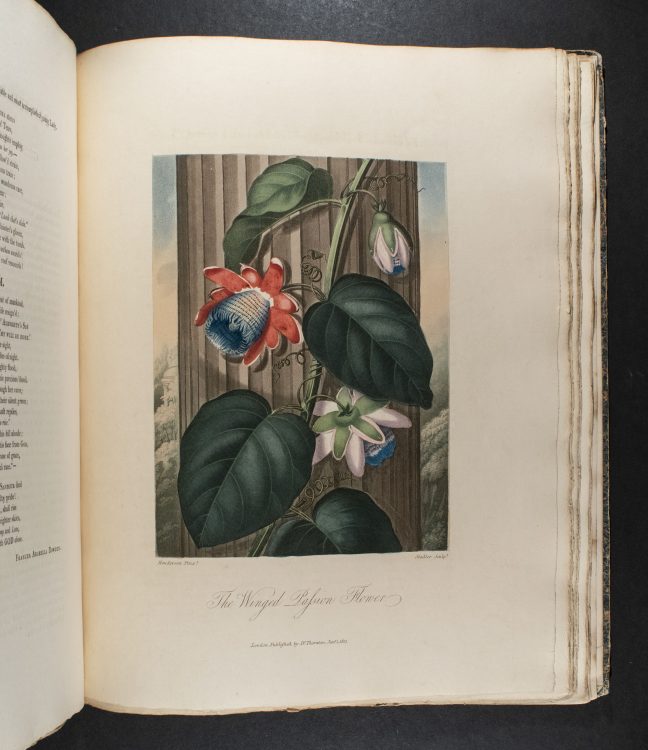
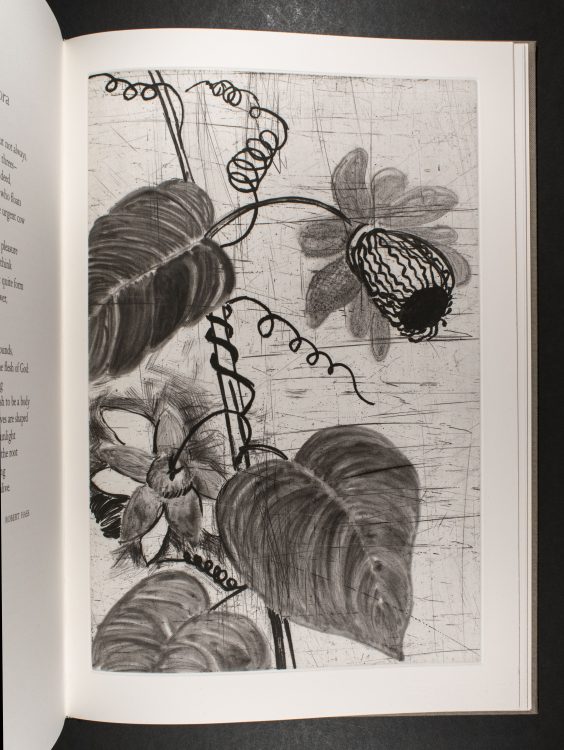
![The Temple of Flora: Twenty-eight Drypoint Engravings [box lid] The Temple of Flora: Twenty-eight Drypoint Engravings [box lid]](https://exhibitions.lib.udel.edu/drawing-connections/wp-content/uploads/sites/65/2020/02/temple_of_flora_case-e1582063499844.jpg)
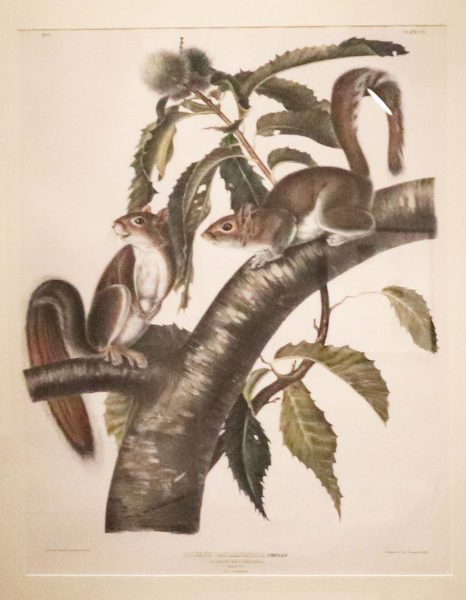

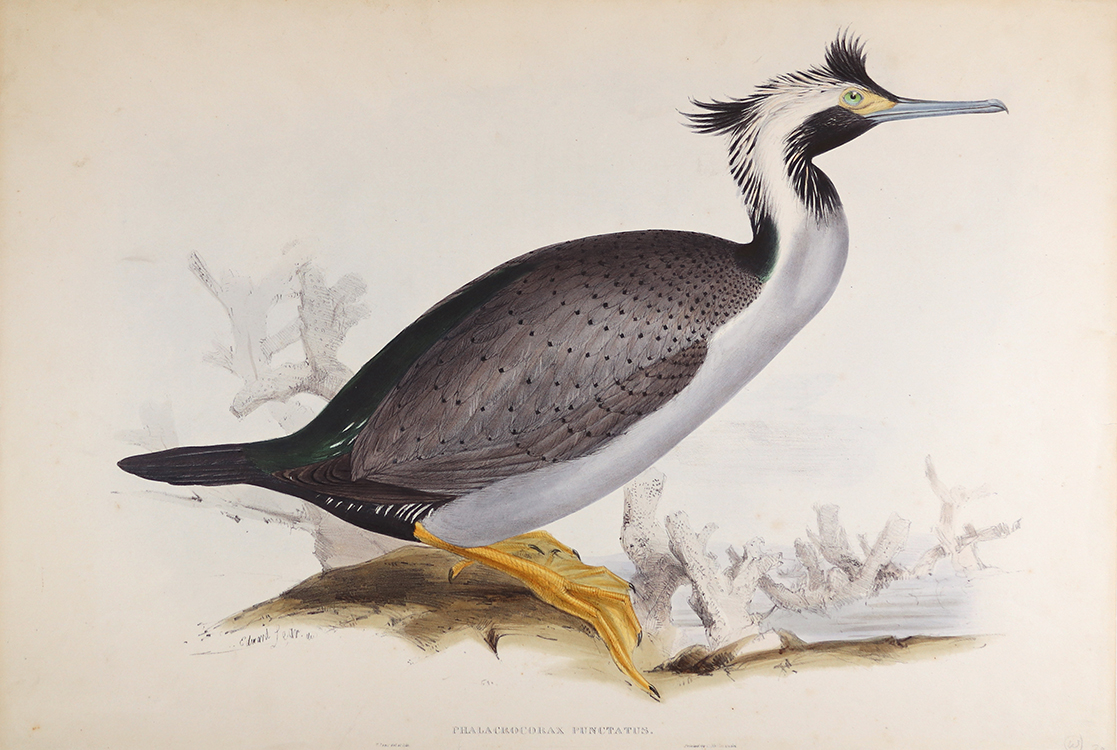
![Circus Jardinii: [Jardine’s Harrier] Circus Jardinii: [Jardine’s Harrier]](https://exhibitions.lib.udel.edu/drawing-connections/wp-content/uploads/sites/65/2020/02/circus-jardinii.jpg)
